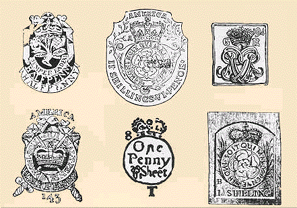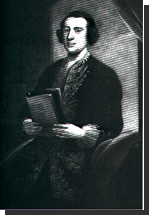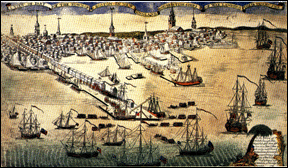The Course
of Revolution
Before the actual war of the Revolution could
begin, there had to be a revolution "in the minds and hearts of the people,"
as John Adams put it. One of the most important factors in this change
of heart was an innocent-looking document which received the assent of
George III "by commission" on March 22, 1765. It was to be known as the
Stamp Act. That it was also to be a piece of political dynamite was soon
evident.
- The American Heritage History of the American Revolution

A tax stamp manufactured for the Stamp Act
In
1765, Parliament passed the Stamp Act. The Act required the colonists
to put stamnps on all printed matter. The colonists strongly opposed this
Act. Mobs made bonfires and burnt heaps of stamps. The merchants boycotted
goods from England so long as the Stamp Act was in force.

Protests against the Stamp Act.
The sign in the background reads:
" The Folly of England and the Ruin of America"
Representative of nine colonies
met in the Stamp Act Congress in New York. They decided that Parliament
had no right to tax the colonies because the colonists were not represented
in Parliament. The colonists created a slogan to challenge the British
rule - "Taxation without representation, is tyranny".

More Stamps.
Parliament had to repeal
the Stamp Act in 1766. However, the British Chancellor of the Exchequer,
Charles Townshend, soon made Parliament pass other acts which imposed taxes
on tea, paper, lead, and paint. This again made the colonists angry as
the British still tried to control them.

Charles Townshend
 In 1768, the Commissioners of Customs, who acquired
their jobs in Britain and drew their pay from what they collected in America,
were so intimidated by the resistance they met in Boston that they demanded
military protection. Boston's fifteen thousand or so residents were
clearly the worst malcontents on the North American continent. It
was imperative that they be put in their place.
In 1768, the Commissioners of Customs, who acquired
their jobs in Britain and drew their pay from what they collected in America,
were so intimidated by the resistance they met in Boston that they demanded
military protection. Boston's fifteen thousand or so residents were
clearly the worst malcontents on the North American continent. It
was imperative that they be put in their place.
General Thomas Gage (Commander In Chief of the
British Army in America) agreed and ordered the regiments (under the command
of British Lt. Colonel William Dalrymple), the "14th West Yorkshire Fuseliers,"
and the "29th Worcestershire," to Boston, which would arrive from Halifax
in September. Six weeks later the "64th" and "65th" Regiments, with
an addition of a detachment of
the "59th" Regiment and a train of artillery with
two cannon -- in all about 700 men -- arrived from Ireland to protect the
men who collected customs duties for the King of England. To the
people of Boston the coming of the troops was outrageous. They had
been fighting for years against infringement by Britain of their right
to tax themselves.
In one of the most famous and elaborate of
Paul Revere's engravings (below), it shows the arrival of the red-coated
British troops. Revere wrote that the troops "formed and marched
with insolent parade, drums beating, fifes playing, and colours flying,
up King Street. Each soldier having received 16 rounds of powder
and ball." Troops of the 29th, unable to secure lodgings in town,
pitched tents on the common. The stench from their latrines wafted through
the little city on every
breeze.

In 1770, while collecting the Townshend duties
in Boston, British troops fired into a crowd, killing five people. This
was known as the Boston Massacre. It made the colonists hate the British
more. So, when order was restored, Parliament removed the taxes. However,
the tea tax was not removed to show that England still had the right to
tax the colonists.
Three years later, Parliament passed the Tea Act to
reduce the tax on tea sold by the East India Company, A British firm. The
Act gave the British merchants an advantage over the colonial merchants.
This made the colonists more angry with the British.
To continue with the Journey through "American History", please click.
Back to the Main Page, please click.






